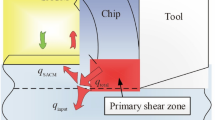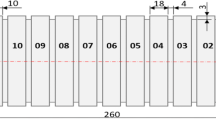Abstract
Surface-active thermal conductive media (SACM) may have the potential to improve the machinability of metallic workpiece material by decreasing cutting temperature. The effect of surface-active thermal conductive media coating on heat dissipation and cutting temperature during orthogonal cutting Inconel 718 is investigated in present study. An enhanced heat transfer model is proposed for the SACM-coated Inconel 718 machined by orthogonal cutting. The cutting temperature into the chip side is predicted with the proposed heat transfer model. The influence of SACM thermal conductivity on cutting temperature is analyzed and discussed. Three SACMs, including silicone grease (15 W/m/K), cupric powder adhesive (40 W/m/K), and graphene (5300 W/m/K), are applied to coat on the Inconel 718 surface to be machined. During SACM-coated Inconel 718 machining, the cutting temperature is measured. The measured cutting temperature decreases as the SACM thermal conductivity increases, which verifies the feasibility of the proposed heat transfer model. From research, it can be concluded that the SACM can improve the machinability of Inconel 718 by decreasing cutting temperature.
Graphical abstract













Similar content being viewed by others
Availability of data and materials
All data and materials used or analyzed during the current study are included in this manuscript.
Code availability
Not applicable.
References
Molaiekiya F, Aliakbari Khoei A, Aramesh M, Veldhuis SC (2021) Machined surface integrity of Inconel 718 in high-speed dry milling using SiAlON ceramic tools. Int J Adv Manuf Technol 112:1941–1950. https://doi.org/10.1007/s00170-020-06471-8
Yin Q, Liu Z, Wang B, Song Q, Cai Y (2020) Recent progress of machinability and surface integrity for mechanical machining Inconel 718: a review. Int J Adv Manuf Technol 109:215–245. https://doi.org/10.1007/s00170-020-05665-4
Oezkaya E, Bücker M, Strodick S, Biermann D (2019) A thermomechanical analysis leading to a novel flank face design providing longer tool lives for tools used in the drilling of Inconel 718. Int J Adv Manuf Technol 102:2977–2992. https://doi.org/10.1007/s00170-019-03417-7
Fan Y, Hao Z, Lin J, Yu Z (2015) New observations on tool wear mechanism in machining Inconel 718 under water vapor + air cooling lubrication cutting conditions. J Clean Prod 90:381–387. https://doi.org/10.1016/j.jclepro.2014.11.049
Chaudhari A, Soh ZY, Wang H, Kumar AS (2018) Rehbinder effect in ultraprecision machining of ductile materials. Int J Mach Tools Manuf 133:47–60. https://doi.org/10.1016/j.ijmachtools.2018.05.009
Rehbinder P (1947) New physico-chemical phenomena in the deformation and mechanical treatment of solids. Nature 159
Udupa A, Viswanathan K, Davis JM, Saei M, Mann JB, Chandrasekar S (2019) A mechanochemical route to cutting highly strain-hardening metals. Tribol Lett 67:1–12. https://doi.org/10.1007/s11249-018-1117-8
Yin Q, Liu Z, Wang B (2021) Machinability improvement of Inconel 718 through mechanochemical and heat transfer effects of coated surface-active thermal conductive mediums. J Alloys Compd 876:160186. https://doi.org/10.1016/j.jallcom.2021.160186
Zhang Y, Li HN, Li C, Huang C, Ali HM, Xu X, Mao C, Ding W, Cui X, Yang M, Yu T, Jamil M, Gupta MK, Jia D, Said Z (2022) Nano-enhanced biolubricant in sustainable manufacturing: from processability to mechanisms. Friction. https://doi.org/10.1007/s40544-021-0536-y
Rosenthal D (1946) The theory of moving sources of heat and its application to metal treatments. Trans ASME 80:849–866
Blok H (1938) Theoretical study of temperature rise at surfaces of actual contact under oiliness lubricating conditions. Proc Gen Discuss Lubr Lubr Inst Mech Eng London 222–235
Jaeger JC (1942) Moving sources of heat and the temperature at sliding contacts. Proc R Soc NSW 76:203–224
Komanduri R, Hou ZB (2001) Thermal modeling of the metal cutting process - part III: temperature rise distribution due to the combined effects of shear plane heat source and the tool-chip interface frictional heat source. Int J Mech Sci 43:89–107. https://doi.org/10.1016/S0020-7403(99)00105-8
Huang K, Yang W (2016) Analytical model of temperature field in workpiece machined surface layer in orthogonal cutting. J Mater Process Technol 229:375–389. https://doi.org/10.1016/j.jmatprotec.2015.07.008
Gao Y, Huang K, Yang W (2020) Analytical model of cutting temperature field in workpiece including uncut chip layer. Int J Adv Manuf Technol 107:3943–3952. https://doi.org/10.1007/s00170-020-05260-7
Li C, Piao Y, Hu Y, Wei Z, Li L, Zhang F (2021) Modelling and experimental investigation of temperature field during fly-cutting of KDP crystals. Int J Mech Sci 210:106751. https://doi.org/10.1016/j.ijmecsci.2021.106751
Yang M, Li C, Zhang Y, Jia D, Li R, Hou Y, Cao H (2019) Effect of friction coefficient on chip thickness models in ductile-regime grinding of zirconia ceramics. Int J Adv Manuf Technol 102:2617–2632. https://doi.org/10.1007/s00170-019-03367-0
Yin Q, Li C, Dong L, Bai X, Zhang Y, Yang M, Jia D, Li R, Liu Z (2021) Effects of physicochemical properties of different base oils on friction coefficient and surface roughness in MQL milling AISI 1045. Int J Precis Eng Manuf - Green Technol 8:1629–1647. https://doi.org/10.1007/s40684-021-00318-7
Yin W, Duan C, Sun W, Wei B (2020) Analytical model of cutting temperature for workpiece surface layer during orthogonal cutting particle reinforced metal matrix composites. J Mater Process Technol 282:116643. https://doi.org/10.1016/j.jmatprotec.2020.116643
Zhao J, Liu Z, Wang B, Hu J (2020) PVD AlTiN coating effects on tool-chip heat partition coefficient and cutting temperature rise in orthogonal cutting Inconel 718. Int J Heat Mass Transf 163:120449. https://doi.org/10.1016/j.ijheatmasstransfer.2020.120449
Kato T, Fujii H (1999) Energy partition in conventional surface grinding. J Manuf Sci Eng Trans ASME 121:393–398. https://doi.org/10.1115/1.2832694
Yang M, Li C, Luo L, Li R, Long Y (2021) Predictive model of convective heat transfer coefficient in bone micro-grinding using nanofluid aerosol cooling. Int Commun Heat Mass Transf 125:105317. https://doi.org/10.1016/j.icheatmasstransfer.2021.105317
Yang M, Li C, Zhang Y, Jia D, Li R, Hou Y, Cao H, Wang J (2019) Predictive model for minimum chip thickness and size effect in single diamond grain grinding of zirconia ceramics under different lubricating conditions. Ceram Int 45:14908–14920. https://doi.org/10.1016/j.ceramint.2019.04.226
Blet N, Maillet D (2022) Analytical steady-state model based on Fourier integral transforms for cylindrical heat pipes under axisymetric conditions. Int J Heat Mass Transf 183:122117. https://doi.org/10.1016/j.ijheatmasstransfer.2021.122117
Chinkanjanarot S, Tomasi JM, King JA, Odegard GM (2018) Thermal conductivity of graphene nanoplatelet/cycloaliphatic epoxy composites: multiscale modeling. Carbon N Y 140:653–663. https://doi.org/10.1016/j.carbon.2018.09.024
Funding
The authors received financial support from the National Natural Science Foundation of China (No. 91860207). This work was also supported by grants from the Taishan Scholar Foundation, the National Key Research and Development Program of China (No. 2019YFB2005401), and the Shandong Provincial Natural Science Foundation of China (Nos. ZR2019MEE073 and 2019JMRH0307).
Author information
Authors and Affiliations
Contributions
Qingan Yin: methodology, investigation, data curation, writing—original draft preparation. Zhanqiang Liu: supervision, conceptualization, writing—reviewing and editing, investigation. Xintang Li: methodology, conceptualization. Bing Wang: methodology, visualization, investigation. Yukui Cai: methodology, investigation. Qinghua Song: visualization, investigation. Xichun Luo: methodology, visualization.
Corresponding author
Ethics declarations
Ethics approval
Compliance with ethical standards.
Consent to participate
All the authors listed agree to participate in this manuscript.
Consent for publication
All co-authors agree to publish the version of this work in the International Journal of Advanced Manufacturing Technology.
Conflict of interest
The authors declare no competing interests.
Additional information
Publisher's Note
Springer Nature remains neutral with regard to jurisdictional claims in published maps and institutional affiliations.
Rights and permissions
About this article
Cite this article
Yin, Q., Liu, Z., Li, X. et al. Heat transfer enhancement with surface-active thermal conductive media coating during orthogonal cutting Inconel 718. Int J Adv Manuf Technol 120, 5823–5833 (2022). https://doi.org/10.1007/s00170-022-09116-0
Received:
Accepted:
Published:
Issue Date:
DOI: https://doi.org/10.1007/s00170-022-09116-0




